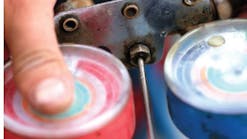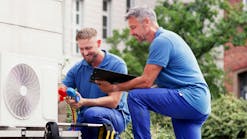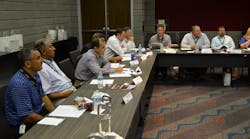“The system is split into three racks. So if one went down, the others could continue. If they lost all three we’d be in trouble as far as obtaining replacement CO2 (due to low supply), but we’re stocking a little bit more now to meet our service needs.”Q: How will the industry adapt to CO2 as it moves toward more widespread use?A: Michael Lehtinen, lead case product manager, Heatcraft Worldwide Refrigeration: “I would say that everyone will give that, ‘I’ll give it a try once’ approach, to a point where a number of retailers who have completed one installation may or may not continue to use it again. But, everybody is seeing the potential in CO2. “I think, initially, there was fear over the higher pressure, and the potential for [in-store accidents]. Over the years, with the safety systems and the number of installations that are out there, the fear has subsided, and it’s become a mental curiosity. Some retailers have fully embraced it.”André Patenaude, director of CO2 business development for Emerson Climate Technologies : “Depending on where you are in the world, the trepidation over CO2 varies. In Europe, there are almost 3,000 transcritical booster sytems installed. They think that number will triple in the next three years. Australia has been using secondary cascade systems, and they’re just starting with boosters in New Zealand. In Canada, we have upwards of 70 booster systems operating, and in 2012, as reported during the ATMOsphere conference, transcritical booster systems were in all the new Canada store platforms," Patenaude explained. “They look at total lifecycle cost of a store; they don’t want to have to put an R-404A or R-407 blend in, and in five years have to do a major retrofit to change that gas again. So, they’re going to spend a little more money today so that, in the future, they’ll save some money.” “In the United States, there are many trials going on. Everyone wants to know for themselves if there’s an energy advantage or not. What are the real tradeoffs for energy, environment, safety, all of those things, in a holistic approach?
One thing is for sure: CO2 is future-phaseout-proof. No matter what the EPA says or does, you won’t be affected by it. We just have to make sure that people working on those systems are properly trained to do the work correctly and safely.” — André Patenaude
Jeff Staub, Danfoss: When you look at parts of HSC and some of your Nordic regions, refrigerants cost 10 to 15 times what we’re paying due to taxes. So, they have no other alternative. And they have national training programs for their contractor base.”
Q: What kind of installation cost difference does a CO2 system bring?
A: Dale Sizemore, Heatcraft Worldwide Refrigeration: “There’s a 40% to 50% higher installation cost, depending on what type of system it is and how much experience they’ve had. In a liquid, for example, there’s a lot of extra components you don’t have in a traditional direct expansion (DX) system. You’ve got pumps, which are one of the largest single, most expensive item in there, and you have two of them, at $5,000 each, that weren’t a part of the old system.”
Sam Wilson: “Then you have steel on the high side, and other things like that that offset the smaller copper side. So you have welded steel for your discharge lines and things like that.”
Dale Sizemore: “Yes, it’s about a half-inch installation, all low-temp liquid overfeed system, so that’s a huge cost.”
Shawn Bosarge, Hussmann Corp.: “We’ve done a few of those transcritical systems. I think what you’re seeing — and the reason you’re seeing it peak and is now coming back down, is some of our customers wanted their own data. So, they did a few installations as pilots, or to set baseline scores. They wanted to get a few running so they could be monitored for the next five years, to see what’s really taking place; what their return looks like, and serviceability.
Attention: Commercial refrigeration contractors with extensive experience in supermarket installation and service. Bring your knowledge and experience to the 2015 Refrigeration Roundtable, to be held in St. Louis, MO, Sept. 14, during Comfortech. We’re seeking five commercial refrigeration contractors who specialize in supermarket systems, and who haven’t yet participated in one of these discussions. Contact Terry McIver, at [email protected].
“In my opinion, it goes back to training. It’s the biggest piece, and the refrigeration technician base isn’t ready for it. We’re still struggling to get technicians to learn DX systems, and now, you’re going to incorporate glycol and CO2? That’s a stretch.”
Dale Sizemore: “That’s exactly true, and just because you change to a CO2 system doesn’t mean the technician can forget how to service DX. He’s got to be solid on the DX first, because the DX is top cycle in running the CO2 or the glycol portion of the rack.”
André Patenaude: “One thing is for sure: a mechanic that doesn’t have a basic grasp of refrigeration is going to have a hard time with CO2. You really need to know the basics. You need to understand pressure, temperature, superheat, subcooling . . . all of those basic principles.
“CO2 is pushing the technology envelope, that’s for sure. On the booster side of things, you’re hearing about ejectors, or transcritical boosters, parallel compression, adiabatic condensors . . . all these new terms. How do we squeeze out that extra bit of efficiency?”
Q: Have you seen any complications with CO2 system start-ups?
Dale Sizemore: “At a Golden Grade store in Tennessee, the rack was in start-up mode, and they discovered that they couldn’t pull temp, couldn’t get the rack running. The closest supply of CO2 was about five hours away. That put them a day behind. Everybody was there for the start-up and the CO2 was contaminated.
“So what do you do? You blow it off and bring in a whole new load. There’s a shortage now because people are stockpiling it.”









